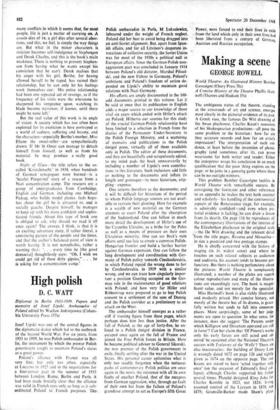World Theatre:. An Illustrated History Bamber Gascoigne (Ebury Press 70s)
Making a scene
GEORGE ROWELL
World Theatre:. An Illustrated History Bamber Gascoigne (Ebury Press 70s) A Concise History of the Theatre Phyllis Hart- noll (Thames and Hudson 35s) The ambiguous status of the-theatre, standing at the crossroads of art and science, emerges most clearly in the pictorial evidence of its past. A Greek vase, the famous De Witt drawing of the Swan playhouse, Charles Kean's souvenirs of his Shakespearian productions—all pose the same problem to the historian : how- far are they accurate records and-how far an artist's impression? The interpretation of such evi- dence, at least before the invention of -photo- -graphy (arid sometimes after it), can prove wearisome for both writer -and reader. Either the interpreter wraps his conclusion in so much qualification that the-poor thing expires on the page; or he joins in a guessing game where there can be no outright winners.
This problem limber -Gascoigne tackles in World Theatre' with remarkable success. By consigning the footnotes` and other references to an appendix he-makes the text both succinct and scholarly—his handling of the controversial aspects of the Renaissance stage, for example, is admirably confident—and even when pic- torial evidence is lacking, he can draw a lesson from its dearth. On page 116 he reproduces all the contemporary illustrations of the interior of the Elizabethan pla.yhouse to the original scale . —the De Witt drawing and the relevant detail ..from the title pages, Roxana. and Messalina- in size a postcard and two postage stamps.
He is chiefly concerned with the history of staging (in its widest sense) and where he touches on -such related subjects as audiences and auditoria, his account tends to become per- functory. But there is nothing perfunctory about the pictures. World Theatre is sumptuously illustrated; a number of the plates are superb colour reproductions and many of the illustra- tions are exceedingly rare. The book is magni- ficent value, and not merely for the specialist.
Miss Hartnoll's book is also richly illustrated and modestly priced. Her concise history, not merely of the theatre but of its drama, is grace- fully written but tends to fall into common- places. More surprisingly, some of her judg- ments are open to question. In what sense, for instance, does she suggest 'The Patents under which Killigrew and Davenant operated are still in force'? Can her claim that 'Of Pinera's works only his early farces are still acted and ad- mired' be sustained after the National Theatre's success with Trelawny of the 'Wells'? There are also inaccuracies: the building of Drury Lane is wrongly dated 1672 on page 126 and rightly given as 1674 on the opposite page. The two Keans are stated to have 'acted together only once' (on the occasion of Edmund's final col- lapse), although Charles supported his father several times. Planche designed King John for Charles Kemble in 1823, not 1824; Irving assumed control of the Lyceum in 1878, not 1879; Granville-Barker made Shaw's plays known to the public at the Court two years be- fore the season of 1906-07. Admittedly these errors all occur in the chapters on the English theatre, but they do not inspire confidence in the other chapters.



































 Previous page
Previous page